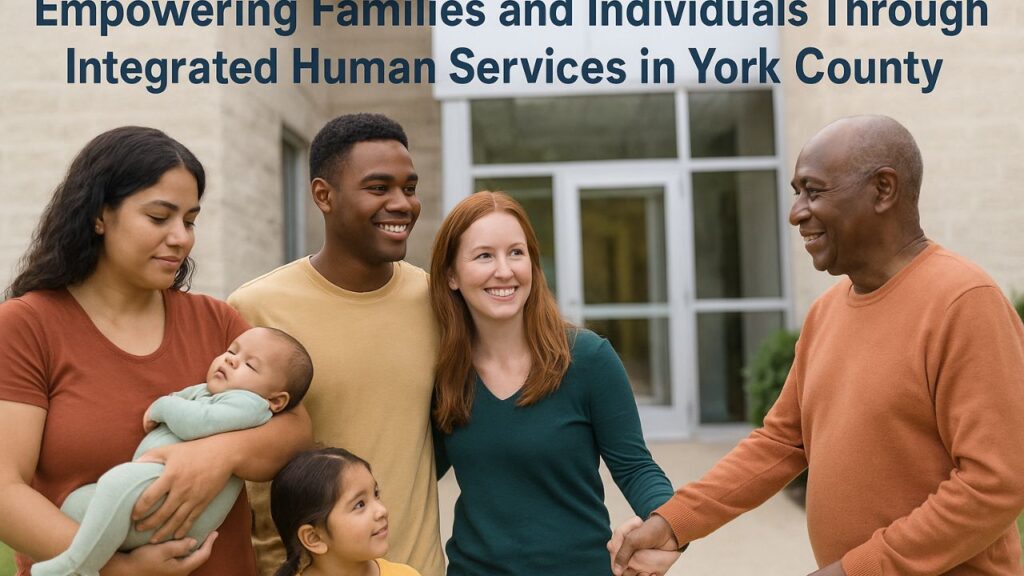Integrated Human Services – In York County, families and individuals face an array of challenges—from economic instability and housing insecurity to health disparities and limited access to essential resources. The York County Human Services Department recognizes these challenges and has responded with a unified, integrated human services approach that is transforming lives across the region. By connecting people to coordinated care and support, York County is creating a sustainable path to stability, independence, and empowerment for thousands of residents.
At the heart of this transformation is a commitment to collaboration, inclusivity, and accessibility. Rather than offering fragmented programs, the County integrates its health, housing, employment, and social welfare services into a seamless support system. This article explores how York County is empowering families and individuals through these innovative human services.
What Is the Integrated Human Services Model?
The integrated human services model combines different government and nonprofit services into one interconnected support system. This means families no longer have to go to multiple agencies for different needs.
Key Features of the Model:
- One-stop access to a range of services
- Case managers assigned to help clients navigate the system
- Data sharing between departments for better coordination
- Focus on prevention, not just crisis management
- Family-centered and culturally sensitive approaches

Departments Involved in the Integration:
| Department Name | Services Offered | Target Groups |
|---|---|---|
| Children, Youth, and Families | Protective services, foster care | Vulnerable children |
| Mental Health & Intellectual Disabilities | Counseling, behavioral support | Adults and children |
| Drug & Alcohol Services | Treatment, recovery programs | Individuals with addictions |
| Area Agency on Aging | Senior services, nutrition, caregiving | Elderly residents |
| Assistance Office (DHS) | SNAP, Medicaid, TANF | Low-income families |
| Housing and Community Development | Rent assistance, shelters | Homeless and at-risk groups |
Programs That Make a Real Difference
York County Human Services offers a variety of programs that are designed to address multiple needs simultaneously—making the system more efficient and effective.
Top Life-Changing Programs:
- Family Engagement Unit: Helps at-risk families improve parenting skills and avoid child welfare involvement.
- Bridge Housing Program: Temporary housing with support services to transition into permanent homes.
- Senior Center Plus: Combines healthcare, recreation, and meals in a supportive environment for seniors.
- STEP Program (Support to Employment Pathways): Prepares individuals to re-enter the workforce.
- Youth Development Services: Educational and mentorship programs for teens and young adults.
Program Overview Table:
| Program Name | Focus Area | Eligibility Criteria | Duration |
|---|---|---|---|
| Family Engagement Unit | Parenting Support | Parents with open cases or referrals | Ongoing support |
| Bridge Housing Program | Homeless Services | Must be homeless or evicted | Up to 24 months |
| STEP Program | Job Training | Unemployed or low-skilled adults | 6–12 months |
| Youth Services | Teen Development | Ages 13–21 | Year-round |
| Senior Center Plus | Elderly Wellness | Seniors 60+ | Flexible |

Community Partnerships and Outreach
Partnerships with local schools, clinics, food banks, and nonprofits amplify the impact of York County’s human services. Outreach campaigns ensure that even the hardest-to-reach families know where and how to get help.
Examples of Local Collaborations:
- WellSpan Health: Provides mental and physical health screenings for program participants.
- Community Progress Council: Assists with financial coaching and childcare for low-income families.
- York City School District: Helps identify children needing social or emotional support.
- United Way of York County: Offers funding and volunteers to support integrated programs.
Digital Access and Technology in Human Services
York County has embraced digital solutions to improve the efficiency and accessibility of its services. Technology bridges the gap between families and government support systems.
Tech Innovations Introduced:
- Online Benefit Application Portal
- Mobile App for Real-Time Service Updates
- Client Dashboards to Track Progress
- Virtual Counseling and Case Reviews
- Hotline Chat Support and Tele-assistance
These tools have drastically reduced wait times, improved transparency, and allowed more personalized services without requiring in-person visits.
Measurable Impact: Real Stories, Real Results
The integrated model is not just theory—it delivers measurable impact on the ground. From helping families avoid homelessness to lifting individuals out of addiction and joblessness, success stories are everywhere.
Key Outcomes:
| Impact Area | Before Integration | After Integration |
|---|---|---|
| Homelessness Rate | 15.4% | 7.9% |
| Employment for Low-Income | 42% | 71% |
| Child Welfare Recidivism | 19% | 8% |
| Senior Care Access | 35% underserved | 85% coverage |
Real-life stories from community members further highlight the emotional and financial relief provided through this integrated model.
Future Plans and Expansion Goals
York County is looking forward to expanding its integrated human services model. With feedback from residents and community partners, the next phase focuses on long-term empowerment rather than just short-term aid.
Future Objectives:
- Expand mobile support vans to rural areas
- Launch trauma-informed care initiatives
- Develop more workforce development partnerships
- Enhance bilingual support and materials
- Increase funding for mental health outreach
The goal is not just to help people survive—but to help them thrive.
FAQs About York County Human Services
Q1. What services are available for families in crisis?
A1. Services include housing support, parenting assistance, job training, and emergency aid.
Q2. How do I apply for help through York County Human Services?
A2. You can apply online or visit your local human services office for in-person support.
Q3. Are the services free of cost?
A3. Most services are free or income-based, depending on eligibility and program guidelines.
Q4. Can seniors get help with home care and meals?
A4. Yes, through the Area Agency on Aging, seniors can access meals, caregiving, and wellness support.
Q5. Is mental health support available for youth?
A5. Yes, counseling and behavioral programs are available for youth through Youth and Family Services.





